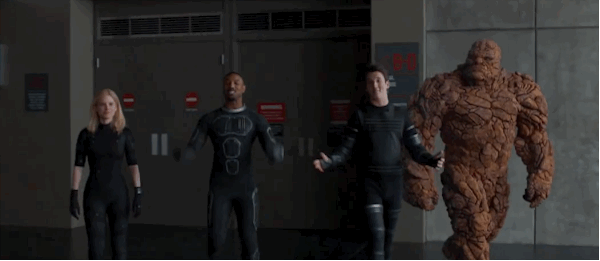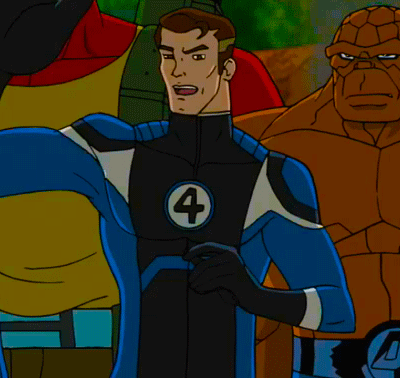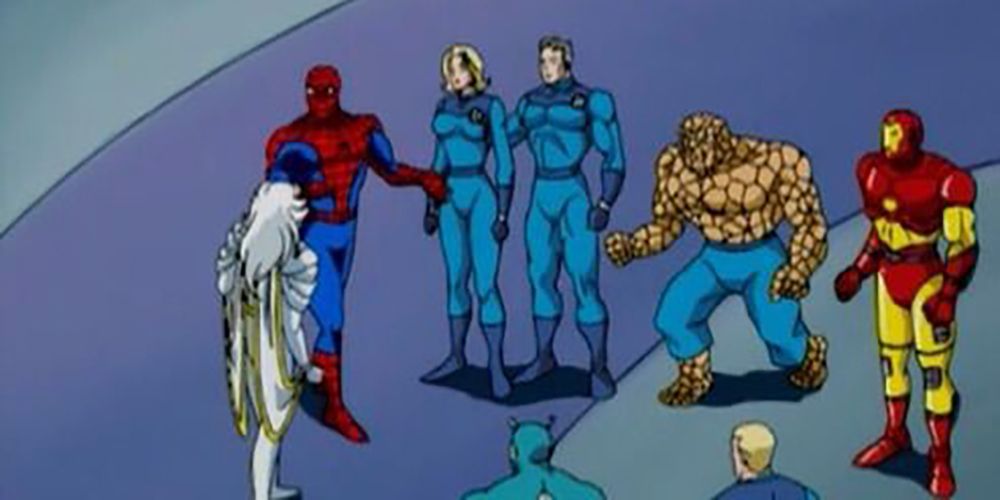Exciting New Releases: ZD Toys Collection
Exciting New Releases: ZD Toys Collection

The Complete History of Fantastic Four in Movies and Animation
July 22, 2025 7 min read
With Marvel’s First Family set to make their much-anticipated debut in the Marvel Cinematic Universe, there’s no better moment than now to rewind the reel and revisit the Fantastic Four’s storied journey through film and television. Over the decades, this iconic team has seen a variety of on-screen incarnations — from live-action blockbusters to animated adventures and surprising cameos across the Marvel multiverse. Some adaptations left fans scratching their heads, while others had them begging for more. As we gear up for their next big-screen evolution, let’s dive into what worked, what flopped, and what made the Fantastic Four such an enduring presence beyond the comic pages.
Fred and Barney Meet The Thing (1979): A Crossover Nobody Expected

In 1979, television took a wild creative leap with Fred and Barney Meet The Thing—a quirky animated series that blended the Stone Age antics of The Flintstones with a completely offbeat reimagining of Marvel’s rocky hero, The Thing. But despite the title, this wasn’t exactly a Marvel crossover fans were expecting. In fact, the show had no trace of the Fantastic Four.
Instead, the spotlight fell on Benjy Grimm, a mild-mannered high school student who could transform into the mighty Thing by clashing together his magical rings and shouting the unforgettable phrase: “Thing Ring, do your thing!” The result? A bizarre, campy version of the beloved character that remains one of the most unusual footnotes in comic-to-screen history.
The Fantastic Four (Unreleased, 1994): The Movie That Was Never Meant to Be

In 1994, legendary B-movie producer Roger Corman delivered what is now known as the most infamous adaptation of Marvel’s First Family — The Fantastic Four. Shot on a shoestring budget and never officially released, the film has earned cult status as perhaps the worst live-action take on the team. Most fans were spared from seeing it, and that may have been for the best.
It was later revealed that the movie was never intended for public release. Instead, it was hastily produced for one reason: to retain the studio’s film rights to the franchise. Even more shocking, this decision was made without informing the cast or crew — explaining the rushed schedule, bargain-bin effects, and overall lack of polish. What was meant to be a superhero epic became a cautionary tale in Hollywood deal-making.
Fantastic Four (1978): The Animated Series with a Surprising Twist

The second animated outing for Marvel’s First Family arrived in 1978 under the title The New Fantastic Four—but this version came with a major shake-up. Due to rights complications, the Human Torch was benched, and in his place came a brand-new character: H.E.R.B.I.E. (Humanoid Experimental Robot, B-type, Integrated Electronics).
While the robotic sidekick was meant to appeal to younger audiences, fans weren’t exactly thrilled with the change. The absence of Johnny Storm’s fiery charisma left a noticeable gap, and the series struggled to gain traction, lasting only a single season. Despite the lukewarm reception, H.E.R.B.I.E. would later find redemption through appearances in the comics, cementing his place—however controversial—in Fantastic Four history.
Fantastic Four (1967): The Animated Debut of Marvel’s First Family

The Fantastic Four made their animated debut in 1967 with a series that aired on ABC, showcasing the original comic book lineup in all their retro glory. Styled in the same animation vein as the hugely popular Spider-Man series from 1966, this show aimed to bring the comic pages to life for Saturday morning audiences.
Faithful to its source material, the series introduced viewers to a host of iconic villains, including the Red Ghost, Diablo, Galactus, and the ever-menacing Doctor Doom. While the show only lasted 20 episodes and never quite reached the cult status of its web-slinging counterpart, it remains a nostalgic milestone—the first time the Fantastic Four’s adventures were brought to the screen.
Fant4stic (2015): A Bold Reboot That Never Took Flight

In 2015, director Josh Trank attempted to reimagine Marvel’s First Family with Fant4stic—a darker, edgier reboot inspired by the Ultimate Fantastic Four comic series. Featuring a younger cast and a tone that blended sci-fi with psychological horror, the film set out to break from tradition and offer something fresh.
But behind the scenes, things took a turn. Extensive reshoots, creative clashes, and heavy studio interference resulted in a disjointed final product that felt worlds apart from its original vision. By the time it hit theaters, Fant4stic bore little resemblance to the iconic team fans knew and loved—and its box office failure reflected that disconnect. Ambitious in concept but muddled in execution, the film remains a cautionary tale of what happens when vision and studio control collide.
Hulk and the Agents of S.M.A.S.H.: A Fantastic Team-Up

While The Thing had already made solo appearances in shows like Ultimate Spider-Man and Avengers Assemble, fans finally got to see the full Fantastic Four unite once again in Hulk and the Agents of S.M.A.S.H. In this episode, Marvel’s First Family teamed up with Hulk, She-Hulk, Red Hulk, Skaar, and A-Bomb to take on an offbeat but formidable threat—an alien invasion by the Tribbitites, a race of aggressive, amphibious foes.
Adding a stylish twist, the Fantastic Four sported costumes inspired by the Ultimate Fantastic Four comics, blending nostalgia with a modern edge. It was a fun, action-packed crossover that brought together two powerhouse teams in a delightfully unexpected way.
Fantastic Four (1994): A Bumpy Ride Through the Marvel Action Hour

In 1994, Fantastic Four joined Iron Man as part of the Marvel Action Hour—a wave of animated series launched to bring Marvel’s most iconic heroes to Saturday morning screens. While the intent was to stay faithful to classic comic arcs, the execution—especially in the first season—left much to be desired.
The early episodes were plagued by awkward dialogue, uneven pacing, and animation that felt more campy than compelling. Thankfully, the series saw a significant improvement in its second season following a change in animation studios, with sharper visuals and more coherent storytelling. Still, despite the upgrade, it never quite managed to capture the heart and soul of the Fantastic Four’s comic book legacy, and ultimately faded into obscurity among its more successful '90s counterparts.
Spider-Man: The Animated Series – A Fantastic Cameo in the Secret Wars Saga

While the Fantastic Four didn’t have a major presence in Spider-Man: The Animated Series during the 1990s, their limited appearances left a lasting impression—especially in the show’s ambitious adaptation of the Secret Wars storyline.
In this arc, Spider-Man was chosen by the powerful Beyonder to lead a team of heroes against a coalition of villains on the mysterious Battleworld. Drawing from his past encounters, Spidey handpicked a roster that included the Fantastic Four, Captain America, Iron Man, Storm, and Black Cat. Though brief, the FF’s involvement added weight to the epic crossover and reminded fans of their place among Marvel’s elite.
Fantastic Four: Rise of the Silver Surfer (2007): A Cosmic Sequel That Fell Flat

Directed by Tim Story, Fantastic Four: Rise of the Silver Surfer hit theaters in 2007 as the follow-up to the franchise’s first live-action outing. The entire original cast returned, this time facing a new, otherworldly threat—none other than the enigmatic Silver Surfer and his ominous master, Galactus.
While the sequel aimed to raise the stakes with a cosmic storyline, it carried over many of the same issues that plagued its predecessor, including uneven tone and underwhelming character development. Most notably, the film’s take on Galactus—depicted not as the iconic, armored Devourer of Worlds, but as a vague, swirling space cloud—left longtime fans deeply disappointed. What could have been a visually stunning and emotionally charged expansion of the FF universe ultimately became a missed opportunity in Marvel’s early cinematic history.
Fantastic Four: World’s Greatest Heroes (2006) – A Stylish, Animated Reinvention

Capitalizing on the momentum from the live-action film, Fantastic Four: World’s Greatest Heroes debuted in 2006, offering fans a fresh, anime-inspired take on Marvel’s First Family. The series opened with a familiar origin story, briefly recapped in its intro, but quickly carved its own identity with mostly original adventures.
Sporting sleek, updated costumes and loaded with high-tech vehicles and gadgets, the show embraced a futuristic aesthetic while staying true to the essence of each character’s powers and personality. While it didn’t follow comic arcs too closely, World’s Greatest Heroes delivered bold visuals, energetic storytelling, and a unique style that helped it stand apart from previous FF adaptations.
Fantastic Four (2005): The Pre-MCU Blockbuster That Brought Marvel’s First Family to Life

Before the Marvel Cinematic Universe reshaped superhero cinema, Fantastic Four hit the big screen in 2005, directed by Tim Story and produced under 20th Century Fox. As the first live-action adaptation of the team to reach theaters, it marked a major milestone for Marvel fans—arriving just a few years before Iron Man would launch the MCU in 2008.
The film starred Ioan Gruffudd as the brilliant Reed Richards, Jessica Alba as the Invisible Woman, Chris Evans—long before his Captain America days—as the fiery Johnny Storm, and Michael Chiklis as the ever-lovable Thing. Julian McMahon took on the role of the iconic villain Doctor Doom. While the movie took creative liberties with the team’s origin and received mixed reactions to its casting choices, it struck a chord with audiences and performed well enough to earn a sequel. For many, it was their first cinematic glimpse of Marvel’s First Family brought to life.
The Avengers: Earth’s Mightiest Heroes – A Standout Fantastic Four Crossover

One of the most faithful animated portrayals of the Fantastic Four didn’t come from their own series—it came during a standout crossover in The Avengers: Earth’s Mightiest Heroes, which aired on DisneyXD. In Season 2, Marvel’s First Family joined forces with Earth’s mightiest team in a memorable episode that showcased both groups at their best.
The plot centered around Doctor Doom, who abducts Wasp and Invisible Woman to investigate his suspicions about the looming Skrull Secret Invasion. What followed was a tightly written, action-packed storyline featuring sharp dialogue, spot-on characterizations, and a dynamic collaboration between the two iconic teams. For many fans, it remains one of the most respectful and well-executed animated representations of the Fantastic Four to date.
Subscribe
Sign up to get the latest on sales, new releases and more …
